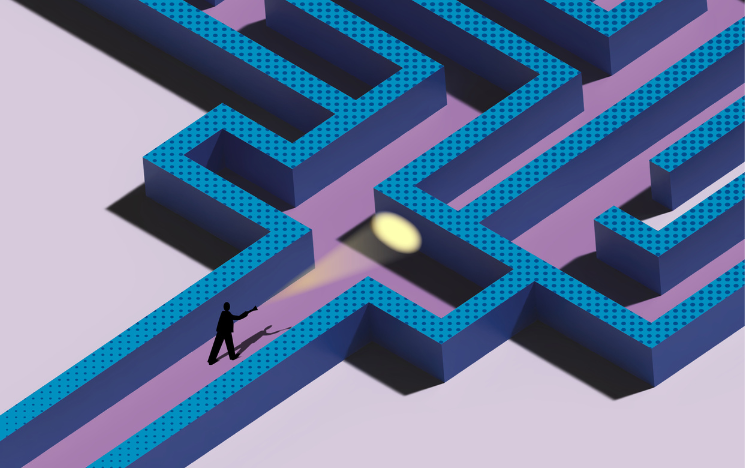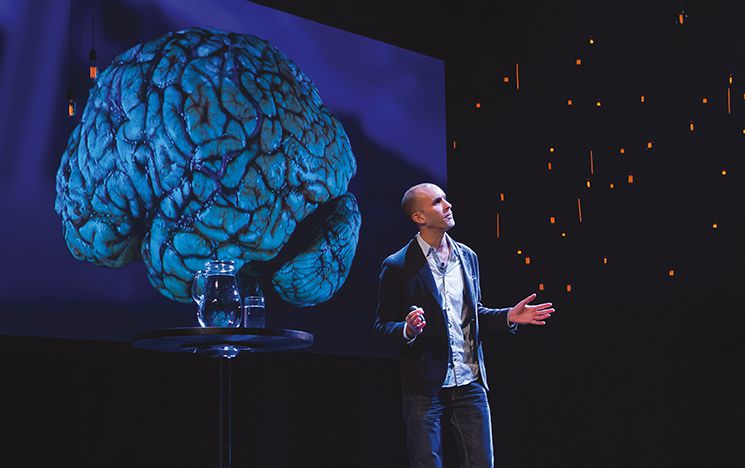
Who do you think you are?
Solving the mystery of consciousness could go beyond understanding our sense of ‘self’ to having broader implications across medicine, society and technology for us all, writes Professor Anil Seth.
The nature of consciousness is truly one of science’s greatest remaining mysteries. We are, each of us, made of physical matter – the same quarks and atoms that make up tables and chairs. And yet somehow, emerging out of all this stuff, we experience the world around us and experience being a ‘self’ within this world. How does this happen? What are the implications of a scientific understanding of consciousness for medicine, society and technology – and for each of us, individually?
In the 1600s, the scientific thinker René Descartes divided the universe into ‘mind stuff’ and ‘matter stuff’, raising the conundrum of how the two might ever interact. More recently, the Australian philosopher David Chalmers distinguished between the ‘easy’ and ‘hard’ problems of consciousness. The easy problems are how the brain and body function as complicated biological objects. The hard problem, echoing Descartes, is how and why physical processing should give rise to conscious experience at all. Many researchers think that this problem is not merely hard, but impossible.
However, in recent history, a vibrant new science of consciousness has taken shape. This has largely been possible thanks to new tools of brain imaging and computational modelling that allow researchers to experimentally study the intimate relationship between the brain and consciousness. Whether these experiments will solve – or dissolve – the hard problem remains to be seen, but the scientific game is most certainly on.
When I came to Sussex in the mid-90s to pursue a Masters, I was already fixated on the problem of consciousness. It was clear that progress on such a fundamental mystery would require uniting many different disciplines. Psychology and neuroscience – the topics of my first degree – wouldn’t cut it alone. My Masters in computer science turned into a PhD, during which I ranged into philosophy, evolutionary computing, cybernetics and more. This multidisciplinary training has been central to the development of my consciousness theories.
We build explanatory bridges from the details of neural circuits to specific aspects of consciousness.” ProfESSOR Anil Seth (informatics 1995)
Director of the Sussex Centre for Consciousness Science
In 2010, Professor of Psychiatry Hugo Critchley and I established one of the world’s first consciousness research centres, positioning Sussex as an international leader in the field. This initiative has now been reborn as the Sussex Centre for Consciousness Science, one of the University’s 12 Centres of Excellence.
We continue to embrace an interdisciplinary ethos – the Centre is based across the Schools of Engineering and Informatics, Psychology, Philosophy and Brighton and Sussex Medical School – and the research is extremely diverse. It ranges from developing new mathematical measures of ‘complexity’ and ‘emergence’ that potentially track how conscious someone is, to advances in the philosophy of mind and artificial intelligence (AI), to detailed psychological experiments that tease apart the factors that influence what people are conscious of when they are conscious – and much more. This diversity of methods and objectives is critical. A centre like ours needs to be open to new ideas, rather than pursuing a single theory or exploiting a single method.
That said, my work focuses on ideas that have been brewing for well over a decade, inspired by many collaborations with colleagues. Here’s the approach: rather than look for some ‘special sauce’ that explains how consciousness arises from non-conscious elements, we build explanatory bridges from the details of neural circuits to specific aspects of consciousness. By explaining why conscious experiences are the way they are, the hope is that the sense of mystery surrounding consciousness will eventually vanish in a puff of metaphysical smoke.
Something like this already happened in how our understanding of life developed. Instead of finding the ‘vital essence’ that distinguished the living from the non-living, biologists explained the properties of living systems – metabolism, homeostasis, etc. – in terms of physics and chemistry. The hard problem of life wasn’t solved, it was dissolved. I’m optimistic that the same may hold for consciousness.
This is where another key idea comes in: that the brain is a ‘prediction machine’ and that every conscious experience is a form of perceptual inference, or ‘best-guessing’. In this view, experiences of the world – and of the self – are not direct readouts of the way the world is, or the way the body is. Instead, the brain is continually making predictions about the causes of sensory signals – those that originate in the world and those that come from the body – and treating the sensory signals as ‘prediction errors’ to update these predictions. Perceptual experience becomes a ‘controlled hallucination’ in which the brain’s best guesses are reined in by sensory signals. We actively construct our worlds and our selves – we don’t passively perceive them.
This view of consciousness has many implications. Here are a few. First, the self isn’t that which does the perceiving; rather, the self is itself a collection of perceptions. This is true even for what we call ‘free will’. Second, we never see the world ‘as it is’. We see it in ways that are useful for staying alive, shaped by our evolutionary history. Third, because we all have different brains, we will all experience a unique, subjectively distinctive world, even for the same shared objective reality. Mapping out ‘perceptual diversity’ is something we are doing in an ambitious new project called The Perception Census, which has already attracted over 30,000 participants from more than 100 countries.
We actively construct our worlds and our selves – we don’t passively perceive them.” ProfESSOR Anil Seth (INFORMATICS 1995)
Director of the Sussex Centre for Consciousness Science
The prospect of developing a scientific understanding of consciousness is hugely exciting. What makes it even more exciting is how this quest is impacting many aspects of society. Within medicine, a deeper understanding of perceptual experience offers powerful new ways to understand and even treat mental health disorders. For immersive technologies, the dramatic acceleration of AI is already raising questions about whether computers could ever be conscious, and only a mature science of consciousness can provide actionable answers. Ethical questions about animal welfare and moral status at the beginning and end of human life all turn on assumptions about when consciousness is present (and if so, what it might be like). In law, whether we hold people responsible for their actions depends on concepts of free will that are increasingly outdated if the self is viewed as a collection of perceptions. A deeper recognition of perceptual diversity can help build new platforms for empathy and understanding.
At the Centre, we pursue the basic science of consciousness and its broader impacts. We’re eager to bring the excitement of consciousness science to wider audiences. Fortunately, many people find consciousness intrinsically fascinating (most people are, after all, interested in themselves!). That said, communicating complex concepts is never easy, and pursuing excellence in public engagement is something we are proud of.
In 2022, we co-developed a project called Dreamachine, which enabled around 40,000 people to safely experience vivid visual hallucinations using a combination of stroboscopic lighting and spatial sound. In March 2024, I delivered the annual Royal Society Michael Faraday Lecture on the topic of consciousness – again reflecting a deep and widely-held interest in this profound mystery.
Will we ever fully solve the mystery of consciousness? It’s hard to know. What’s clear is that consciousness research is already changing our understanding of human experience, both in society at large and to each of us individually. The ability to experience the world – and the self – is the everyday miracle that brings meaning to our brief moments in the light of existence.
 Anil Seth delivering a talk on consciousness in Attenborough Centre for Creative Arts.
Anil Seth delivering a talk on consciousness in Attenborough Centre for Creative Arts.
Professor Anil Seth is Professor of Cognitive & Computational Neuroscience (Informatics) at Sussex, and Director of the Sussex Centre for Consciousness Science, one of the university's 12 Centres of Excellence.